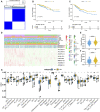Identification of Epithelial-Mesenchymal Transition-Related lncRNAs that Associated With the Prognosis and Immune Microenvironment in Colorectal Cancer
- PMID: 33898515
- PMCID: PMC8059639
- DOI: 10.3389/fmolb.2021.633951
Identification of Epithelial-Mesenchymal Transition-Related lncRNAs that Associated With the Prognosis and Immune Microenvironment in Colorectal Cancer
Abstract
Background: The expression of long non-coding RNA (lncRNA) is associated with the epithelial-mesenchymal transition (EMT) in tumorigenicity, but the role of EMT-related lncRNA in colorectal cancer (CRC) remains unclear. Methods: The clinical data and gene expression profile of CRC patients were obtained from The Cancer Genome Atlas database. Differential expression analysis, Cox regression model, and Kaplan-Meier analysis were used to study the relationship between EMT-related lncRNAs and the prognosis of CRC. Functional analysis and unsupervised clustering analysis were performed to explore the influence of certain lncRNAs on CRC. Finally, Cytoscape was used to construct mRNA-lncRNA networks. Results: Two signatures incorporating six and ten EMT-related lncRNAs were constructed for predicting the overall survival (OS) and disease-free survival (DFS), respectively. Kaplan-Meier survival curves indicated that patients in the high-risk group had a poorer prognosis than those in the low-risk group. The results of the functional analysis suggested that the P53 and ECM-receptor pathways affect the prognosis of CRC, and AL591178.1 is a key prognostic EMT-related lncRNA, which is negatively related to immune cells, P53 pathway, and ECM-receptor pathway. Conclusion: Six OS-related and ten DFS-related EMT-related lncRNAs were correlated with the prognosis of CRC by potentially affecting the immune microenvironment, and AL591178.1 plays a key role as a prognostic factor.
Keywords: colorectal cancer; epithelial-mesenchymal transition; immune cells; lncRNA; prognosis.
Copyright © 2021 Liu, Hu, Li, Jiang and Zhao.
Conflict of interest statement
The authors declare that the research was conducted in the absence of any commercial or financial relationships that could be construed as a potential conflict of interest.
Figures







Similar articles
-
Identification of Epithelial Mesenchymal Transition-Related lncRNAs Associated with Prognosis and Tumor Immune Microenvironment of Hepatocellular Carcinoma.Dis Markers. 2022 Jan 15;2022:6335155. doi: 10.1155/2022/6335155. eCollection 2022. Dis Markers. 2022. PMID: 35111268 Free PMC article.
-
Identification and Validation of EMT-Related lncRNA Prognostic Signature for Colorectal Cancer.Front Genet. 2021 Sep 22;12:723802. doi: 10.3389/fgene.2021.723802. eCollection 2021. Front Genet. 2021. PMID: 34659346 Free PMC article.
-
Identification of N6-methylandenosine related lncRNA signatures for predicting the prognosis and therapy response in colorectal cancer patients.Front Genet. 2022 Sep 30;13:947747. doi: 10.3389/fgene.2022.947747. eCollection 2022. Front Genet. 2022. PMID: 36246627 Free PMC article.
-
Identification of MFI2-AS1, a Novel Pivotal lncRNA for Prognosis of Stage III/IV Colorectal Cancer.Dig Dis Sci. 2020 Dec;65(12):3538-3550. doi: 10.1007/s10620-020-06064-1. Epub 2020 Jan 20. Dig Dis Sci. 2020. PMID: 31960204 Review.
-
Long non-coding RNAs as the critical regulators of epithelial mesenchymal transition in colorectal tumor cells: an overview.Cancer Cell Int. 2022 Feb 10;22(1):71. doi: 10.1186/s12935-022-02501-5. Cancer Cell Int. 2022. PMID: 35144601 Free PMC article. Review.
Cited by
-
Development and Validation of an 8-Gene Signature to Improve Survival Prediction of Colorectal Cancer.Front Oncol. 2022 May 10;12:863094. doi: 10.3389/fonc.2022.863094. eCollection 2022. Front Oncol. 2022. PMID: 35619909 Free PMC article.
-
Large tumor suppressor 2 is a prognostic biomarker and correlated with immune infiltrates in colorectal cancer.Bioengineered. 2021 Dec;12(2):11648-11661. doi: 10.1080/21655979.2021.1996513. Bioengineered. 2021. PMID: 34699318 Free PMC article.
-
Identification of Epithelial-Mesenchymal Transition- (EMT-) Related LncRNA for Prognostic Prediction and Risk Stratification in Esophageal Squamous Cell Carcinoma.Dis Markers. 2021 Oct 19;2021:5340240. doi: 10.1155/2021/5340240. eCollection 2021. Dis Markers. 2021. PMID: 34712369 Free PMC article.
-
Identification of modules and key genes associated with breast cancer subtypes through network analysis.Sci Rep. 2024 May 29;14(1):12350. doi: 10.1038/s41598-024-61908-4. Sci Rep. 2024. PMID: 38811600 Free PMC article.
-
Long Non-coding RNA Signature for Liver Metastasis of Colorectal Cancers.Front Cell Dev Biol. 2021 Jul 8;9:707115. doi: 10.3389/fcell.2021.707115. eCollection 2021. Front Cell Dev Biol. 2021. PMID: 34307387 Free PMC article.
References
-
- Ahlén Bergman E., Hartana C. A., Johansson M., Linton L. B., Berglund S., Hyllienmark M., et al. (2018). Increased CD4+ T cell lineage commitment determined by CpG methylation correlates with better prognosis in urinary bladder cancer patients. Clin. Epigenet 10 (1), 102. 10.1186/s13148-018-0536-6 - DOI - PMC - PubMed
-
- Cerami E., Gao J., Dogrusoz U., Gross B. E., Sumer S. O., Aksoy B. A., et al. (2012). The cBio cancer genomics portal: an open platform for exploring multidimensional cancer genomics data. Cancer Discov. 2 (5), 401–404. 10.1158/2159-8290.cd-12-0095 - DOI - PMC - PubMed
-
- Chen C. L., Mahalingam D., Osmulski P., Jadhav R. R., Wang C. M., Leach R. J., et al. (2013). Single-cell analysis of circulating tumor cells identifies cumulative expression patterns of EMT-related genes in metastatic prostate cancer. Prostate 73 (8), 813–826. 10.1002/pros.22625 - DOI - PMC - PubMed
LinkOut - more resources
Full Text Sources
Other Literature Sources
Research Materials
Miscellaneous

